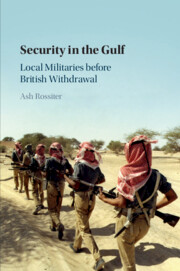Book contents
- Security in the Gulf
- Security in the Gulf
- Copyright page
- Contents
- Preface
- Abbreviations
- Introduction
- 1 Patterns of Protection in the Gulf
- 2 British India and Local Security Arrangements
- 3 Local Militaries and Intensified British Interests
- 4 Intervention or Local Means of Coercion?
- 5 Local Forces and Britain’s Silver Age in the Gulf
- 6 Securing the Gulf after Britain’s Withdrawal
- Conclusion
- References
- Index
1 - Patterns of Protection in the Gulf
Published online by Cambridge University Press: 15 June 2020
- Security in the Gulf
- Security in the Gulf
- Copyright page
- Contents
- Preface
- Abbreviations
- Introduction
- 1 Patterns of Protection in the Gulf
- 2 British India and Local Security Arrangements
- 3 Local Militaries and Intensified British Interests
- 4 Intervention or Local Means of Coercion?
- 5 Local Forces and Britain’s Silver Age in the Gulf
- 6 Securing the Gulf after Britain’s Withdrawal
- Conclusion
- References
- Index
Summary
Piracy combined with heightened Anglo-French rivalry led Britain to reconsider the level of its involvement in the Gulf at the end of the eighteenth century. Against the backdrop of punitive naval action, Britain proposed a “General Treaty of Peace with the Arab Tribes.” Signatories would refrain from piracy and fly a registered flag; British naval power would guarantee the peace. With these maritime truces in place, British officials now referred to Eastern Arabia as the Trucial coast rather than the pirate coast. Britain further bound itself through Exclusive Treaties to defend the territorial integrity of the tiny shaikdoms, but was unwilling and ill-equipped to deal with trouble on land. Before the formation of organised and centrally controlled security forces, the leading shaikhs of Eastern Arabia relied on tribal alliances to defeat or deter rival claimants; to defend key settlements and vital wells against aggressors; and to embark on expeditions against neighbors. With a small band of armed retainers, the leading shaikhs were unable to exercise much political control within their territories In the 1920s, Britain began to change this by establishing local militaries.
Keywords
- Type
- Chapter
- Information
- Security in the GulfLocal Militaries before British Withdrawal, pp. 6 - 22Publisher: Cambridge University PressPrint publication year: 2020

